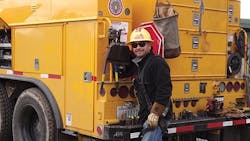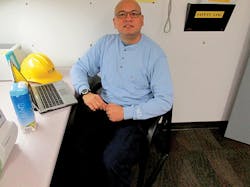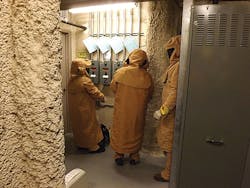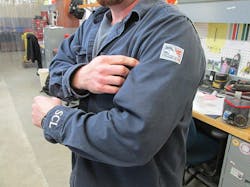Not long ago, a limited number of vendors designed and created flame-resistant (FR) garments for electric utility linemen. As such, much of the clothing was stiff, heavy, scratchy, hot and uncomfortable, and linemen had a slim selection to choose from when it came to colors and styles.
Today’s FR work clothing, however, rivals mainstream fashion, and it is nearly impossible to distinguish FR shirts, pants and outerwear from its non-FR counterparts. For example, since Seattle City Light rolled out its official flame-resistant clothing program back in 2012, the industry has continued to mature, and vendors have come out with clothing for both female and male linemen.
In addition to noticing an improvement in the style of the clothing, City Light’s safety team has also recognized a higher level of protection against arc flash for its 650 employees who wear FR clothing daily and the 300 who wear it on an intermittent basis.
Creating a Committee
Unlike other utilities that work with multiple garment vendors, City Light works with a single company to supply the FR clothing to its operations workforce. Every three years, the City of Seattle invites companies to bid on a contract, and then the winning vendor has an exclusive arrangement with City Light to outfit its linemen with its FR workwear. Currently, Tyndale USA is partnering with City Light on its FR program.
To select which garments will appear in City Light’s customized catalog, the utility created a committee to lend a hand. This committee is comprised of safety, health and wellness employees, including Kathy Prappas and Kevin Davis, as well as members of the operations staff, including Jason Trotter, Jonathan Finch, Morgan Rice, Tom Rabbitt and Shari Rider.
Committee members work together to create a specialized catalog of FR workwear that includes long-sleeve shirts, pants, outerwear, sweatshirts, hoodies and jeans. Depending upon where the catalog is in the production process, the committee meets every other week, month or quarter. If they are working up against a print deadline, they tend to meet more often than when the selection process has been completed.
Because the front-line employees wear the FR clothing day in and day out, they are instrumental in helping to select options for their fellow linemen. The six- to eight-person committee, which includes representatives from IBEW Local 77, focuses specifically on FR protection.
City Light created the committee after some of its operations employees asked for FR clothing that was more fashion-forward and comfortable. In response, the committee looked for garments that not only protected the linemen, but were also more on trend and modern.
Guarding Against Arc Flash
Before selecting which garments can be included in the City Light catalog, the utility’s engineers determined the level of protection linemen need in the operations. That way, all of the choices are appropriate for the work that needs to be done and adhere to the standards and requirements.
All of the clothing, whether it is a pair of FR jeans or a button-up shirt, is designed to extinguish flames and protect the worker from arc flash hazards. While City Light has certain policies and procedures in place to protect against arc flash, if an employee is exposed to these hazards, he or she will be protected as much as possible from burn-related injuries.
To ensure the linemen have the highest available level of protection, they are encouraged to properly maintain their FR workwear. For example, they are advised to wash their FR clothing separately from other clothing, pull it out of the dryer halfway through the cycle and let it dry on its own, and pay attention to the manufacturer care tags.
In addition, they must inspect their clothing on a regular basis. If a garment has any tears, it must be discarded and replaced immediately; otherwise, it will not offer protection.
Selecting Garments
Instead of taking a traditional top-down approach, City Light actively engages its linemen and other operations workers in its decision-making process for its FR clothing. The management does not mandate that the operations workers wear a specific style and color of FR clothing, but rather gives employees a wide selection of garments to select from.
For example, they can now select from garments in a variety of colors like blue, red and tan, patterns including plaid and checkered, and styles such as button-up and pullovers. Also, the linemen can order garments with or without the City Light logo on it.
Every year, the operations employees have a maximum allocated allowance of about $1,500 for daily wear with coveralls and rollover, and they can order FR clothing from an online or print catalog. The committee regularly reviews the clothing that the employees aren’t wearing as often and makes recommendations for existing garments to be taken out or new garments to be added to the catalog.
Showcasing New Garments
To help the operations workforce to decide which garments to order, City Light requests samples of the new clothing from its contracted vendor. Over several months, the committee members test and evaluate selected items based upon their style, comfort and wearability before the utility then takes these clothing items on a “road show.”
The committee designates a time, day and location, and then invites the linemen to come to a certain service center to view the new clothing that will appear in the catalog. That way, the linemen aren’t selecting their garments based solely on a picture and description but can actually feel the material. Also, if it is an appropriate size, they can even try it on to determine the best fit.
Over the years, City Light has done more to engage its employees in the decision-making process for FR clothing. As such, the operations workforce can now feel more comfortable, whether they are installing power lines or restoring power following a severe storm.
Darwyn Anderson is the safety, health and wellness director for Seattle City Light. He has been with the utility since 2013 and began working with the city of Seattle in 1993. Over the years, he has served in various administrative leadership roles related to safety.





